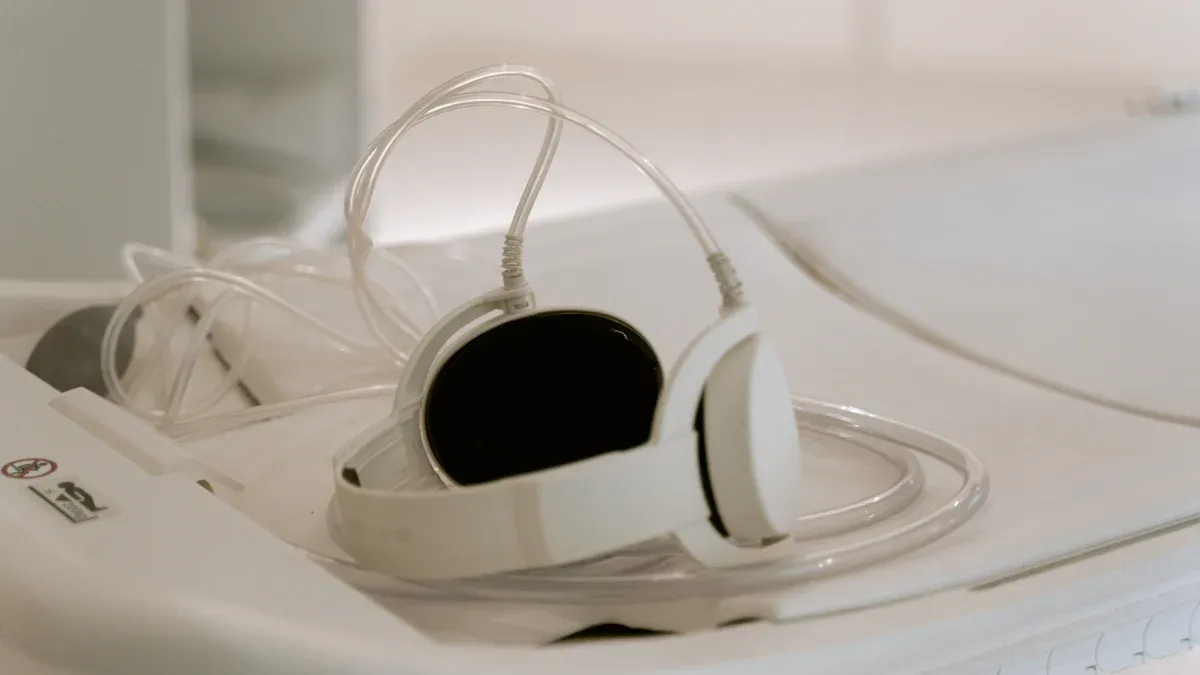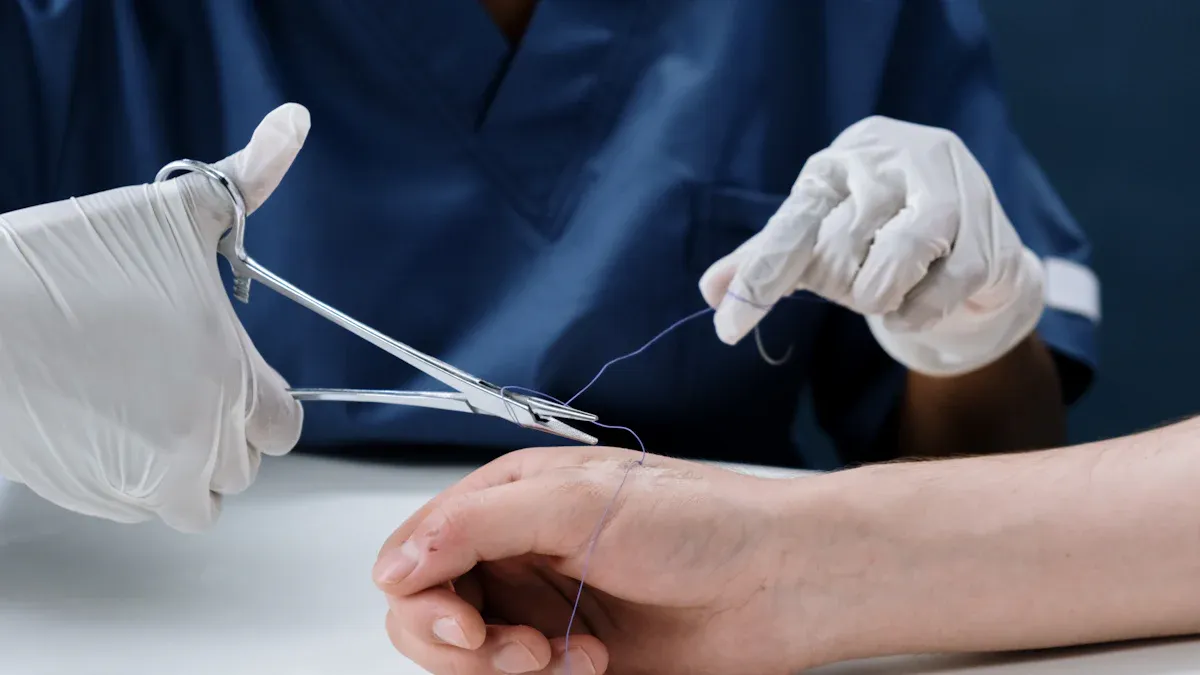Comparing Nitinol and Cobalt-Chromium Tubing for Thrombectomy Stent Durability

When you compare nitinol vs. cobalt-chromium tubing for thrombectomy stent durability, you typically find that nitinol stents offer superior fatigue resistance, while cobalt-chromium stents provide higher radial strength. Durability in thrombectomy stents means the ability to resist fracture, fatigue, and corrosion, which helps maintain patency. You need to consider stent performance over time, as patency and long-term outcomes depend on material choice. The right stent supports patency, reduces complications, and improves thrombectomy results. When you evaluate nitinol vs. cobalt-chromium tubing for thrombectomy stent durability, focus on mechanical properties, biocompatibility, corrosion resistance, and clinical performance. Patency remains a crucial marker for stent success, so your decision impacts both patency and reintervention rates. Selecting the best stents for thrombectomy helps you maintain patency and achieve optimal outcomes for your patients.
Key Takeaways
Nitinol stents offer excellent flexibility and fatigue resistance, making them ideal for vessels that move or bend often during thrombectomy.
Cobalt-chromium stents provide strong radial force to keep vessels open but may be less flexible and more prone to permanent deformation.
Nitinol stents cause less inflammation and lower clot risk, supporting faster healing and better long-term vessel openness.
Good corrosion resistance in stents helps maintain durability and reduces complications, with nitinol showing strong performance when properly finished.
Choosing the right stent design and material improves patient outcomes by maintaining vessel patency and reducing the need for repeat procedures.
Nitinol vs. Cobalt-Chromium Tubing for Thrombectomy Stent Durability

Mechanical Strength
When you compare nitinol vs. cobalt-chromium tubing for thrombectomy stent durability, you notice clear differences in mechanical strength. Cobalt-chromium stents offer high radial strength, which means they can resist vessel recoil and maintain vessel diameter after deployment. This property is important in thrombectomy, where you want the stent to keep the vessel open and support patency. Cobalt-chromium stents also have high tensile strength, making them less likely to deform under pressure. However, these stents tend to be less flexible, which can limit their use in tortuous or highly mobile vessels.
Nitinol stents, on the other hand, provide a balance of strength and flexibility. Nitinol’s superelasticity allows the stent to recover its shape after being compressed or bent. This property is especially useful in thrombectomy procedures that require the stent to navigate complex vascular paths. Nitinol stents can expand to their preset shape without balloon assistance, which reduces the risk of vessel injury. The manufacturing process, including precise heat treatment and composition control, ensures that nitinol stents maintain both strength and flexibility. You benefit from a stent that adapts to the vessel while still providing enough force to support patency.
Tip: Choose cobalt-chromium stents when you need maximum radial strength, but consider nitinol stents for vessels that require more flexibility and adaptability.
Fatigue Resistance
Fatigue resistance plays a major role in the long-term durability of thrombectomy stents. In the context of nitinol vs. cobalt-chromium tubing for thrombectomy stent durability, nitinol stands out for its ability to withstand repeated deformation. Nitinol stents can endure large strains—up to 400-500%—without fracturing. This means the stent can flex and move with the vessel, especially in areas like the femoropopliteal arteries, where movement is constant. Cyclic mechanical testing confirms that nitinol stents maintain their tensile strength and recover their shape even after repeated bending.
Cobalt-chromium stents, while strong, are more prone to plastic deformation. When you use these stents in areas with frequent movement, they may not return to their original shape after being bent. This can lead to permanent deformation or even fracture, which threatens patency and increases the risk of reintervention. For thrombectomy, where vessel movement and repeated stress are common, nitinol’s superior fatigue resistance gives you a clear advantage.
Flexibility and Shape Memory
Flexibility and shape memory are defining features of nitinol stents. When you deploy a nitinol stent during thrombectomy, it expands and conforms to the vessel’s unique anatomy. This adaptability is possible because of nitinol’s shape memory and superelasticity. The stent can return to its original shape after deformation, which prevents irreversible damage and maintains vessel patency. This property is especially valuable in complex or curved vessels, where a rigid stent might fail.
Nitinol stents self-expand, adapting to vessel changes without the need for a balloon.
They withstand large strains and recover their shape, even after significant deformation.
The stent’s mesh design supports blood flow and reduces the risk of aneurysm rupture.
Clinical studies show a 76% complete occlusion rate for aneurysms treated with nitinol stents, with low morbidity and mortality.
Manufacturing advances, such as heat treatment and precise composition control, optimize flexibility and durability.
The titanium dioxide layer on nitinol stents enhances corrosion resistance and biocompatibility, supporting long-term patency.
Cobalt-chromium stents, in contrast, rely on balloon expansion and do not possess shape memory. They are less suitable for vessels that require frequent flexion or adaptation. If you need a stent for a dynamic vascular environment, nitinol offers better performance and durability.
Note: The choice between nitinol and cobalt-chromium stents affects not only immediate thrombectomy success but also long-term outcomes like patency and the need for future interventions.
Biocompatibility and Thrombogenicity
Tissue Response
When you choose a stent for thrombectomy, you need to think about how your body will react to the material. Nitinol and cobalt-chromium stents both serve as intravascular stents, but they trigger different tissue responses. Nitinol stents usually cause less inflammation. Your vessel wall heals faster, which helps maintain patency and lowers the risk of occlusion. Cobalt-chromium stents can sometimes cause more irritation. This irritation may slow healing and increase the chance of scar tissue forming inside the stent. Scar tissue can block blood flow and lead to occlusion, which threatens stent patency and increases the risk of stroke.
You want a stent that supports healing and keeps the vessel open. Nitinol stents often perform better in this area. They help your vessel recover after thrombectomy and keep blood moving. This support for patency is important for patients who have had a stroke or face a high risk of large vessel occlusion.
Tip: If you want to reduce inflammation and help your vessel heal, consider a nitinol stent for your thrombectomy procedure.
Thrombosis Risk
Thrombosis, or blood clot formation, is a major concern after you place a stent. Both nitinol and cobalt-chromium stents can trigger clotting, but their risk profiles differ. Nitinol stents have a smooth surface and a special oxide layer. This layer makes it harder for clots to form, which helps maintain patency and lowers the risk of occlusion. Cobalt-chromium stents may have a higher risk of thrombosis, especially if the vessel wall does not heal quickly.
You need to keep stent patency high to prevent another stroke. If a clot forms and causes occlusion, blood cannot reach the brain, and the risk of stroke rises. Intravascular stents that resist thrombosis help you avoid this problem. Clinical studies show that nitinol stents often have lower rates of occlusion and better patency after thrombectomy. This advantage can make a big difference for patients with acute ischemic stroke or large vessel occlusion.
Nitinol stents support long-term patency and reduce the need for repeat procedures.
Cobalt-chromium stents may require closer monitoring for occlusion and stroke risk.
Intravascular stents with good biocompatibility improve outcomes after thrombectomy.
Note: Always consider thrombosis risk when you select a stent for thrombectomy. Better patency means a lower chance of stroke and fewer complications.
Corrosion Resistance

Long-Term Stability
When you select a stent for thrombectomy, you want to know how it will perform over time inside the body. Corrosion resistance plays a key role in the long-term stability of both nitinol and cobalt-chromium stents. In laboratory tests, researchers polish nitinol stents with acidic electrolytes. This process removes surface oxides and impurities, creating a smooth surface that resists corrosion. The polished nitinol stent releases fewer nickel ions, which helps protect your vessel from toxic effects and supports better biocompatibility. Cobalt-chromium stents also undergo surface polishing to improve their corrosion resistance. However, findings from orthopedic implants show that cobalt-chromium alloys can develop pitting corrosion if not processed correctly. Even though these alloys maintain structural integrity in most cases, you must ensure proper surface treatment to minimize corrosion risk.
Aspect | Nitinol (NiTi) | Cobalt-Chromium-Molybdenum (CoCrMo) |
|---|---|---|
Surface Preparation | Electrolytic polishing | Electrolytic polishing |
Corrosion Testing | Potentiostatic, OCP, fretting-corrosion | Same methods |
Key Findings | Reduced nickel release, smooth surface | Benchmark alloy, needs careful processing |
A 6-month animal study shows that nitinol stents with polished surfaces keep nickel levels low in both blood and tissue. This reduces inflammation and supports vessel healing. You can trust that a well-finished nitinol stent will remain stable and safe in vascular environments.
Impact on Stent Longevity
Corrosion affects how long a stent lasts and how safe it is for your patients. If a stent corrodes, it can release metal ions and debris, which may trigger inflammation or even lead to implant failure. Intravascular stents rely on protective oxide layers to resist corrosion. However, inflammation in the vessel can break down these layers, increasing the risk of ion release and chronic inflammation. This process can threaten stent patency and raise the chance of occlusion or stroke.
You want to choose stents that maintain their structure and function for as long as possible. Nitinol stents with optimized surfaces show minimal nickel release and low rates of local tissue reaction. Cobalt-chromium stents, when properly processed, also offer good corrosion resistance, but you must monitor them for signs of pitting or wear. Clinical and in vitro studies link corrosion behavior directly to stent longevity and patient safety. If you focus on corrosion resistance during stent selection, you help ensure better outcomes for rescue intracranial stenting, acute ischemic stroke, and large vessel occlusion cases.
Tip: Always check the surface finish and corrosion data when you evaluate stents for thrombectomy. Better corrosion resistance means longer-lasting stent patency and fewer complications.
Clinical Outcomes in Thrombectomy
Fracture and Failure Rates
You need to understand how stent fracture and failure rates affect outcomes in thrombectomy. When you compare nitinol vs. cobalt-chromium tubing for thrombectomy stent durability, you see differences in how these stents perform under stress. Some nitinol stents, like the Bard Luminexx, show higher fracture rates, especially in long segments or areas with high mechanical stress. Other nitinol stents, such as Dynalink or Edwards Lifestent NT, have lower fracture rates. Cobalt-chromium stents, like the Wallstent, tend to resist fracture better in many cases. You can see the comparison in the table below:
Aspect | Nitinol Stents (e.g., Bard Luminexx, Dynalink/Absolute, Edwards Lifestent NT) | Cobalt-Chromium Stents (e.g., Wallstent) |
|---|---|---|
Fracture Rate | Bard Luminexx: high; others: lower | Less prone to fracture |
Radial Force | Higher than Wallstent | Lower than nitinol stents |
Flexibility | Flexible, may spring forward | Highly flexible, braided design |
Patency & Complications | No significant difference at 1 year | Comparable at 1 year |
You should pay attention to fracture risk, especially in rescue intracranial stenting for large vessel occlusion or acute ischemic stroke. Fracture can lead to occlusion, loss of patency, and higher stroke risk.
Patency and Reintervention
Patency is a key measure for stent success in thrombectomy. You want to keep the vessel open and avoid occlusion. Studies show that both nitinol and cobalt-chromium stents achieve similar patency rates at one year. For example, in a study of nitinol stents for superior vena cava occlusion, the reocclusion rate was 10%. Most patients with symptomatic occlusion needed reintervention, such as restenting or thrombolysis. You see similar patency and reintervention rates with cobalt-chromium stents. Maintaining patency reduces the risk of stroke and the need for repeat procedures.
Key Clinical Studies
Several clinical trials compare stent patency and outcomes in thrombectomy. The DESTINY and ACHILLES studies show that drug-eluting stents improve patency compared to bare-metal stents. In the PADI trial, patency trends favor drug-eluting stents, but both nitinol and cobalt-chromium stents show similar results for limb salvage and occlusion rates. The EXPAND study found no significant difference in reintervention rates between stent types at one year. You should focus on patency, occlusion, and stroke prevention when choosing a stent for rescue intracranial stenting or large vessel occlusion. Good patency means fewer strokes and better long-term outcomes.
Tip: Always monitor for occlusion and loss of patency after thrombectomy. Early detection and reintervention can prevent stroke and improve survival.
Practical Considerations
Device Design
When you select a stent for thrombectomy, you need to consider how design affects both ease of use and clinical performance. The SWIFT trial showed that operators with no prior experience using the Solitaire stent retriever could perform safe and effective thrombectomy. This rapid learning curve means you can adopt new devices quickly, which benefits your patients. Compared to older devices, Solitaire achieved higher reperfusion rates, required fewer device passes, and resulted in better outcomes for disability and mortality. Early use by inexperienced operators did not reduce success, so you can trust the device’s user-friendly design.
Stent design also shapes how well you can capture and remove clots. Finite-element modeling studies reveal that the size, structure, and deployment method of a stent influence how it interacts with both the vessel and the clot. You must match the stent’s features to the patient’s anatomy and the characteristics of the clot. This approach helps you reduce the risk of clot fragmentation and improve patency, especially in rescue intracranial stenting for large vessel occlusion or acute ischemic stroke.
Choose stents with proven ease of use for faster adoption.
Match stent design to vessel anatomy and clot type for better outcomes.
Consider device flexibility and adaptability in dynamic vascular environments.
Cost and Availability
Manufacturing and customization play a big role in the cost and availability of stents. You see differences between nitinol and cobalt-chromium stents in how they are made and tailored for specific needs.
Customization Aspect | Description |
|---|---|
Composition Adjustments | Adjusting metal ratios to modify heat response, rust resistance, and strength. |
Thermomechanical Processing | Heat and cold treatments to enhance strength, flexibility, and shape memory. |
Dimensional Specifications | Precise control over tubing size, length, and surface finish for medical use. |
Nitinol stents rely on extrusion, drawing, and heat treatment to achieve tight tolerances and shape memory. This process allows you to customize the stent for different vessel sizes and clinical scenarios. Cobalt-chromium stents often use selective laser melting, which builds the stent layer by layer. This method lets you create complex designs and adjust strut thickness, but it can increase production costs and affect surface quality.
When you choose a stent, balance the need for customization with cost and availability. For rescue intracranial stenting, you may need a highly specialized device. In other cases, standard stents offer reliable performance at a lower cost.
Tip: Work with device manufacturers to ensure you have access to stents that fit your clinical needs and budget.
When you select a stent for thrombectomy, you must focus on patency. Nitinol stents often provide better patency because they resist fracture and support vessel healing. Cobalt-chromium stents offer strong patency in some cases, but you may see more occlusion. You should always monitor patency after placing a stent to prevent occlusion and reduce stroke risk. Choose a stent that matches vessel needs and supports long-term patency. You can help improve patency by working with device designers. Future research should explore new stent materials that keep patency high and lower occlusion and stroke rates.
FAQ
What makes a stent durable in thrombectomy procedures?
You want a stent that resists fracture, fatigue, and corrosion. Durability depends on the material, design, and how well the stent maintains patency. Both nitinol stent and cobalt-chromium stents offer unique strengths for thrombectomy.
How does stent patency affect stroke risk?
Stent patency means the vessel stays open. If you lose patency, occlusion can occur. This blocks blood flow and raises your risk of stroke. You should always monitor stent patency after thrombectomy to prevent complications.
Why do some stents fail after thrombectomy?
Stents may fail due to fracture, poor flexibility, or corrosion. Movement in the vessel, especially in rescue intracranial stenting or large vessel occlusion, can stress the stent. Choosing the right stent helps you avoid occlusion and repeat procedures.
Are nitinol stents better than cobalt-chromium stents for acute ischemic stroke?
Nitinol stents offer better flexibility and fatigue resistance. You may prefer them for acute ischemic stroke or dynamic vessels. Cobalt-chromium stents provide higher radial strength. Your choice depends on the vessel and the specific needs of thrombectomy.
How do intravascular stents reduce the need for reintervention?
Intravascular stents support vessel healing and maintain patency. When you select a stent with good corrosion resistance and flexibility, you lower the risk of occlusion. This reduces the chance you will need another procedure after thrombectomy.

